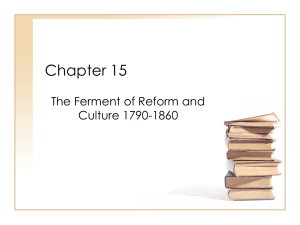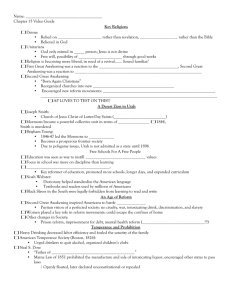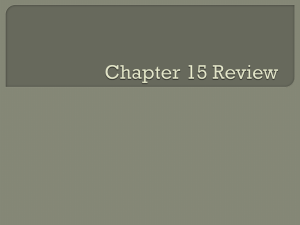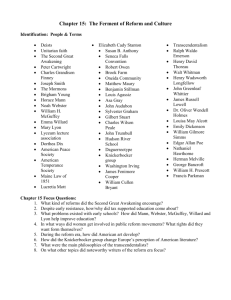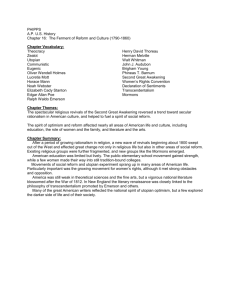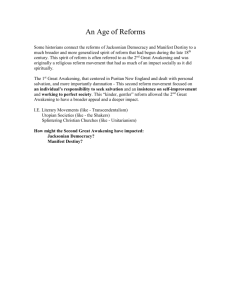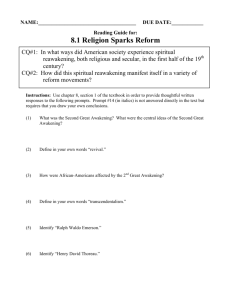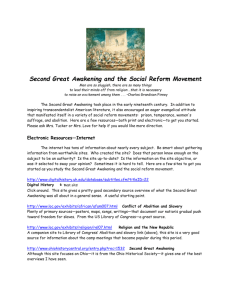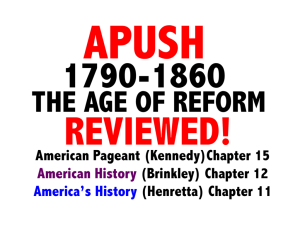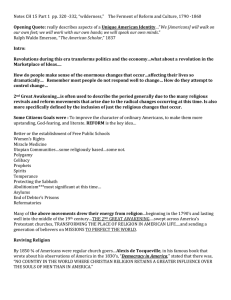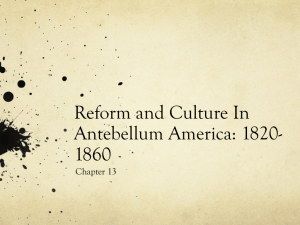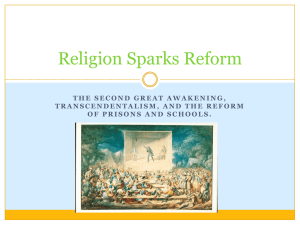The Ferment of Reform and Culture
advertisement
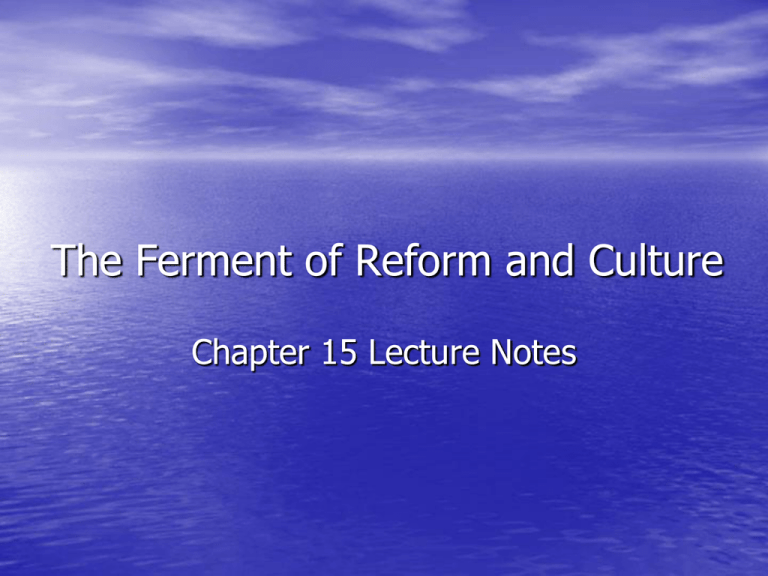
The Ferment of Reform and Culture Chapter 15 Lecture Notes The Ferment of Reform and Culture •Guiding Question: To what extent were the 2nd Great Awakening reformers “moral busybodies” as the Jacksonians had claimed? Faith in America: 1800-1850 • 75% of all Americans attended church regularly • in 1850. Many people began looking to science for religious answers including Thomas Jefferson and Ben Franklin. – “Deists” believed in a Supreme Being but relied on reason rather than revelation and refuted the ideas of Christ’s divinity and original sin – Deism helped inspire the Unitarian faith in New England which put forth the ideas that God existed in only one person (no trinity), denied the deity of Jesus, and stressed the essential goodness of human nature; popular with intellectuals who did not believe in the hellfire and brimstone of traditional religion. The Second Great Awakening • It was a boiling reaction against the growing religious liberalism that had sprung up around 1800; it inspired many powerful movements across the country – Revivals: religious meetings where people met and experienced the hellfire gospel – Reform: changes in many areas of American life specifically the altering of systems that might be bad for humanity – Feminization: women took a more active role in bringing their families back to God and saving the rest of society Denominational Diversity • Great Awakening widened differences between classes and regions – Eastern areas not as affected by revivalism • Upper classes in these areas stayed with conservative, traditional churches (Episcopalians, Presbyterians, and Congregationalists). – Southern and western areas most strongly affected • Methodists and Baptists (and other revival sects) grew among poorer, less educated people The Second Great Awakening • New Religious Denominations – Millerites (Adventists): group that rose from the “Burned-Over District” (area in Western New York where descendents of New England Puritans preached hellfire!); Several hundred thousand members believed that Christ would return to earth on 10/22/1844; He didn’t quite make it and the movement slowed down a bit but did not destroy it. The Second Great Awakening • New Religious Denominations – Church of Jesus Christ of Latter Day Saints (Mormons): founded in the Burned-Over District by Joseph Smith around the 1830 who claimed to have received golden plates from an angel---he deciphered the tablets and they constituted the Book of Mormon. Serious opposition arose after the founding of the church due to drilling a militia and accusations of polygamy; Upon Smith’s death, Brigham Young led the Mormons to Utah where they flourished and practiced their religious customs; Utah was denied statehood until 1896 because of their acceptance of polygamy and the anti-polygamy laws that Congress had passed Changes in Education • Free Public Schools: driven by • reformers like Horace Mann, states campaigned for more and better schools, longer school terms, higher pay for teachers, and an expanded curriculum (beyond the traditional 3-Rs “readin’, ‘ritin’, and ‘rithmetic”) Improved Textbooks: encouraged by people like Noah Webster who designed reading lessons, schools began to promote patriotism through literacy; William H. McGuffey sold 122 million copies of the McGuffey Reader which hammered home lessons in morality, patriotism, and idealism. Higher Education • State-Supported Colleges and Universities – Federal land given so as to build campuses – University of Virginia (1819): founded by Thomas Jefferson as an institution for free thinkers of the natural sciences and liberal arts – Women’s schools: gained respectability around 1820 • Troy Female Seminary (1821) • Oberlin College (1837) • Mount Holyoke Seminary (1837) • Libraries: Private and Tax-Supported collections • of books Lyceum Lecture Associations: Speakers would travel and lecture on topics like science, literature, and moral philosophy Reform Movements • Areas of concern for reform: – Debtor’s Prisons were gradually abolished – Capital Offenses were reduced and punishments that were extremely cruel were eliminated – Insane Asylums were reformed • Dorothea Dix: traveled all over the country documenting the ills of life in the asylums until many legislatures improved conditions – Drinking: Organizations like the American Temperance Society challenged alcohol and its social ills; promoters looked to prohibit alcoholic consumption Women in Revolt • Gender differences strongly emphasized – Market Economy separating men and women • Women: physically and emotionally weak, but artistic and refined; endowed with moral sensibility and responsible to teach the young how to be good, productive citizens in the Republic • Men: strong but crude; always in danger of slipping into some savage or beastly way of life – “Cult of Domesticity”: the concept that the proper role of women was to manage their homes and be good wives and mothers Women in Revolt Women’s Rights Movement – Organized the Women’s Rights Convention in Seneca Falls, NY in 1848. • Declaration of Sentiments: “all men and women are created equal” • Leaders of the convention: Susan B. Anthony and Elizabeth Cady Stanton – Women challenged the man’s world • Elizabeth Blackwell: 1st female grad of medical school • Grimke Sisters: championed antislavery • Lucy Stone: retained her maiden name after marriage • Amelia Bloomer: wore a shorter skirt with Turkish Trowsers or “Bloomers” underneath Wilderness Utopias • Robert Owen: – Seeking human betterment, Owen used his vast financial resources to set up New Harmony in Indiana; harmony did not prevail as the population consisted of hard-working visionaries and dirty, rotten scoundrels which made for a confused environment • Brook Farm: – 20 intellectuals committed to transcendentalism founded this community in Massachusetts; was very successful until a fire destroyed a communal building; debt ruined the establishment--they truly bought the farm! Hehe • Oneida Community: – Founded in New York, this experimental society practiced free love and even worked to select parents to produce superior offspring; it flourished for 30+ years largely because its artisans made great steel items “American” Art, Literature, and Thought • Art: – Gilbert Stuart (1755-1828): talented artist who wielded his brush in Britain in competition with the best artists; painted several portraits of George Washington--most being idealized and dehumanized – Charles Willson Peale (1741-1827): Maryland artist who painted Washington 60+ times of which Washington sat for fourteen of them! – John Trumbull (1756-1843): Revolutionary War veteran who painted spirited scenes of the glorious victory over Britain The Surrender of Lord Cornwallis---John Trumbull George Washington---Gilbert Stuart “American” Art, Literature, and Thought • Literature: – Knickerbocker Group of New York: group of writers who wrote boastful literature to match America’s landscape – Washington Irving (1783-1859): first American to win international acclaim with stories like Rip Van Winkle and The Legend of Sleepy Hollow. – James Fenimore Cooper (1789-1851): the first American novelist who wrote books like The Spy (American Revolution story) and The Last of the Mohicans “American” Art, Literature, and Thought • Thought: – Transcendentalism: movement in the 1830s that attempted to liberalize the Puritan theology; belief that truth “transcends” the senses and cannot be found through observation; influenced heavily by the Romantics of Europe • Ralph Waldo Emerson: the “Transcendental MAN”! Known for his collections of essays; namely, Self Reliance and Experience • Henry David Thoreau: nonconformist; author of Walden and Civil Disobedience • Walt Whitman: poet of the movement; author of collection called Leaves of Grass T Ralph Waldo Emerson
